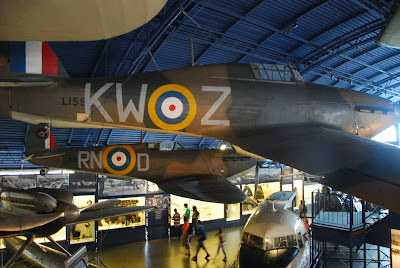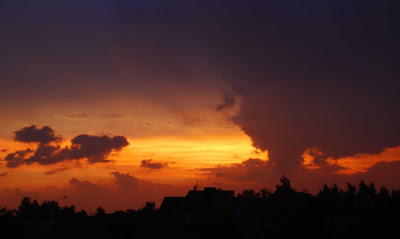
Sunshine and rain, as
Frankie Beverly of
Maze so appositely observed, are like joy and pain. The weekend, stretching into Monday, has been thus. The view from the upstairs bathroom window on Saturday afternoon says it all (
right). Much of last week was just plain old sopping wet.
Another road trip beckoned on Sunday, this time up to the Lithuanian frontier - 680 km (450 miles) there and back - to drop off our daughter Monika at girl guides' camp. We set off in sunshine at 05:30; half an hour later we were in Praga, on the right bank of the Vistula river. Here, shafts of early-morning light illuminated the Orthodox Cathedral (
below). As we left Warsaw, the sky clouded over.

North-east Poland has had the worst of the recent rains. As we left Mazowsze and entered Podlasie, rivers were swollen, fields had standing water on them, storks looked bedraggled and mud-streaked. This pair (
below) look decided unhappy with the situation.

I felt sorry for the scouts and guides that had spent the last week under canvas; the forecasts look little better. The camp itself was at the end of a 2km grass track through fields and forest. It was so wet that twice our Yaris was threatened with being stuck in axle-deep mud. We made it there, I barely made it back out. The camp reminded me of a Warsaw Pact version of Kit and Holly's forest hideout in
Badlands. Monika (
below, left, pink top and jeans) was pleased to join her guide group, which was just having tent inspection as we arrived.

The camp being a mere 5km from the Lithuanian border, I decided to take a look before heading back for home. The road to the border (
below) was unchanged from 1939; overgrown cobblestones. This being the former Polish-Soviet border, the lie of the land was quite different to the
Polish-Czech border we visited in May. There were no houses within 5km of either side of the border. Arriving at there, I saw signs saying 'No photography'. The border guards said there was nothing to photograph anyway - just trees. The border itself was marked by a 60m wide ploughed strip. Although today there's no barbed wire, dogs or mines, the atmosphere was far more intimidating than at the Czech border, despite this being a common EU crossing. Our Yaris emerged triumphant despite a caking in mud and a clattery ride over broken road surfaces.
Heading back to Warsaw, I chose the more direct though narrower road through Lomza. The landscapes quite different from the Lublin road, travelled on Thursday, somehow the trip home was less joyous. However, the road again creates associations with America, a constant theme running through this blog like Route 66 itself.

 See her jump on the trampoline, oh yeah! Next stage of our UK travels take us to Wheathampstead, Hertfordshire, to the residence of my old friend from university, Nick, and his family. As at my brother's house, a trampoline features in the garden. Here is Monika airborne over a field full of cows above. Below: Nick's cottage, rendered in the style of a 1930s Frank Newbould railway poster.
See her jump on the trampoline, oh yeah! Next stage of our UK travels take us to Wheathampstead, Hertfordshire, to the residence of my old friend from university, Nick, and his family. As at my brother's house, a trampoline features in the garden. Here is Monika airborne over a field full of cows above. Below: Nick's cottage, rendered in the style of a 1930s Frank Newbould railway poster.






















































